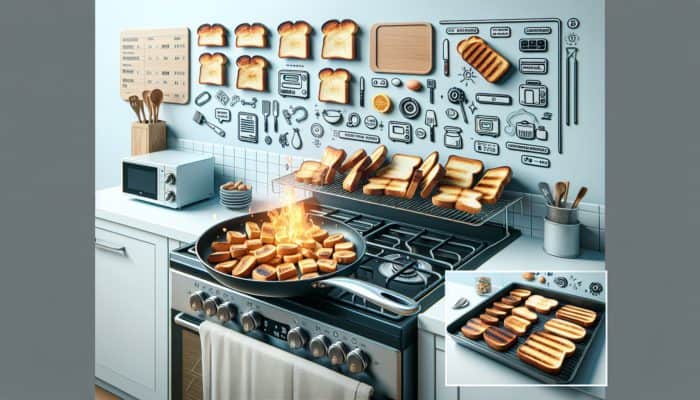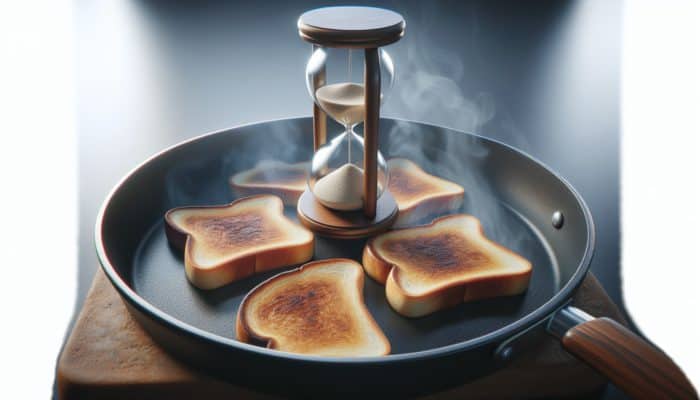Essential Kitchen Tools for Perfectly Toasted Bread: Elevate Your Toasting Game
Discover the Most Effective Kitchen Equipment for Toasting Bread

Exploring the myriad techniques for creating toast without relying on a conventional toaster unveils an exciting array of culinary methods, each harnessing unique kitchen tools to deliver distinct flavours and textures. The most recommended tools include:
- Frying Pan: This versatile option is ideal for stovetop toasting, as it provides excellent control over direct heat, resulting in quick and satisfying results.
- Oven: Perfect for batch toasting, this method guarantees an even golden finish on multiple slices simultaneously, making it efficient for larger gatherings.
- Grill: This method imparts a delightful charred flavour to the bread, making it particularly suitable for thicker slices that benefit from a smoky taste.
Utilising a frying pan is often considered the most approachable and user-friendly method, offering a close-up view of the toasting process to ensure the bread reaches the ideal level of crispiness. Although the oven method may take more time, it excels in consistently toasting larger quantities efficiently, ideal for family breakfasts. Grilling, on the other hand, adds a unique flavour that enriches the toast experience, especially if you desire a hint of smokiness in your meal. Each technique can be customised to accommodate different types of bread and the specific results you wish to achieve.
Effective Preparation Techniques for Your Bread Prior to Toasting
Preparing your bread correctly is essential for achieving optimal results before embarking on your toasting journey. Begin by allowing your bread to reach room temperature, which is crucial for ensuring even toasting throughout. Here are some effective tips for preparing your bread:
- Slice Evenly: Ensure your bread is cut into uniform slices, promoting consistent toasting across all pieces.
- Consider the Type of Bread: Each bread type has unique toasting characteristics, and recognising these can lead to superior outcomes.
- Storage Conditions: Use bread that has been stored properly to prevent sogginess or excessive dryness, both of which can ruin your toast.
Slicing your bread evenly is vital, as it ensures that each piece receives consistent heat exposure, significantly reducing the likelihood of some slices burning while others remain undercooked. When selecting your bread, consider how different varieties—such as wholemeal, sourdough, or brioche—react to heat. For instance, denser breads like sourdough might require a slightly longer toasting time compared to lighter options. Additionally, proper bread storage will greatly enhance its toasting quality; stale or excessively moist bread can lead to disappointing results when it comes to achieving that perfect toast.
Essential Safety Measures for Toasting Bread Without a Toaster
Toasting bread without a toaster introduces specific safety considerations that must be acknowledged. By following a few straightforward safety tips, you can ensure the process is both effective and secure. Here are the essential precautions to keep in mind:
- Use Oven Mitts: Protect your hands from burns when handling hot pans or trays, as bread can become dangerously hot.
- Stay Attentive While Toasting: Keep a close watch on your bread to prevent burning, as it can quickly turn from perfectly toasted to charred.
- Ensure Proper Ventilation: Open windows or use exhaust fans to mitigate smoke build-up, especially when using high-heat methods like grilling or broiling.
Wearing oven mitts is essential, particularly when handling hot surfaces or flipping slices in a frying pan. It's important to note that bread can transition swiftly from perfectly toasted to burnt, making vigilance a necessity. Furthermore, ensuring that your kitchen is well-ventilated is crucial for managing smoke, particularly when using high-heat methods such as grilling or broiling. By prioritising safety, you can enjoy a risk-free and pleasurable toasting experience.
Mastering Advanced Techniques for Toasting Bread Using a Frying Pan

Preparing Your Frying Pan for Optimal Toasting Results
Setting up your frying pan effectively for toasting is a straightforward yet impactful process. Start by heating your pan over medium heat, which is ideal for achieving even toasting without the risk of burning your bread too quickly. If desired, adding a small amount of butter or oil can enhance the flavour while helping to prevent sticking. Once the pan attains the correct temperature, carefully place your bread inside, ensuring there is enough space between slices for optimal heat distribution.
It is essential to flip the bread regularly to achieve perfect toast. Each side requires close monitoring; if the bread begins to darken too quickly, adjusting the heat may be necessary. A practical approach is to check the bread every 30 seconds to evaluate its toastiness. This method allows you to adapt to the thickness of the bread and your preferred level of crispiness. Ultimately, using a frying pan grants you complete control over the toasting process, leading to outstanding results.
Identifying the Ideal Temperature for Frying Pan Toasting
The ideal temperature for toasting bread in a frying pan is medium heat. This setting strikes the perfect balance, allowing the bread to toast evenly without the risk of burning. Excessively high heat can lead to charring the exterior while leaving the interior soft and undercooked. Conversely, too low a heat may result in limp and unappetising toast.
Maintaining this medium heat may require periodic adjustments based on the type of bread you are toasting. For example, denser varieties like wholegrain or sourdough may benefit from a longer toasting time at this temperature. If your initial attempts yield uneven results, take note of the heat levels and adjust accordingly. A consistent temperature will ensure a reliable toasting experience, guaranteeing that each slice meets your expectations for texture and flavour.
Recommended Toasting Duration in a Frying Pan

Toasting bread in a frying pan generally takes around 2-3 minutes per side, depending on your heat settings and the type of bread being used. It is crucial to keep a vigilant eye on your bread during this process to prevent overcooking or burning. The timing may vary based on the thickness of the slices; thicker pieces will typically require more time to achieve the desired crispness.
For the best results, flip the bread halfway through the toasting process. This practice not only promotes even browning but also allows you to monitor the progress closely. If you have a specific level of crispness in mind, feel free to adjust the time accordingly. Some people prefer a light toast, while others enjoy a darker, crunchier finish. By mastering the timing, you can perfect the art of frying pan toasting.
Utilising Different Types of Bread for Frying Pan Toasting
Absolutely, various types of bread can be successfully toasted in a frying pan. Whether it’s white, wholemeal, or artisan sourdough, each type offers distinct flavours and textures when toasted. However, the toasting duration may need to be adjusted based on the density and moisture content of the bread.
Lighter breads, such as white sandwich bread, will toast more quickly, often requiring less time than denser varieties like rye or sourdough. It’s also important to consider the thickness of the slices; thicker slices generally necessitate a longer toasting duration. Experimenting with different kinds of bread can lead to delightful discoveries, as each type offers unique flavours that can elevate your meal. This versatility is what makes using a frying pan such an excellent method for toasting.
Professional Tips for Toasting Bread Without a Toaster
Culinary Expert Techniques for Toasting Bread
Culinary professionals often recommend specific techniques for toasting bread without the reliance on a traditional toaster, emphasizing methods that enhance both flavour and texture. Grilling is a popular choice among chefs, as it imparts a charred flavour that many find appealing. The high heat from grilling caramelises the sugars in the bread, yielding a beautifully textured crust. Alternatively, the oven is renowned for its even toasting capabilities, especially when preparing larger quantities of bread.
Chefs may also advise pairing certain types of bread with specific methods. For example, sourdough is frequently grilled to achieve a smoky flavour, whereas lighter breads are better suited to the oven for consistent toasting. This expert insight underscores the importance of selecting the appropriate method based on the type of bread used, ensuring that every slice is toasted to perfection.
Strategies for Consistently Perfectly Toasted Bread
Achieving consistently perfectly toasted bread requires meticulous attention and strategic adjustments tailored to your kitchen setup. A key step is to monitor the bread closely throughout the toasting process, which helps you catch any potential issues before they escalate, ensuring your toast maintains the ideal colour and texture.
Another critical factor is adjusting the heat settings. Many chefs recommend starting at medium heat and modifying as necessary. If you observe that the bread is toasting too rapidly, reducing the heat can help. Conversely, if you prefer a darker toast, a slight increase in temperature may be warranted. Additionally, flipping the bread regularly ensures even browning. By implementing these actionable steps, you can refine your toasting technique and consistently produce excellent results.
Avoiding Common Mistakes When Toasting Bread
When toasting bread without a toaster, several common pitfalls can undermine your efforts. A significant issue arises from using excessively high heat, which can scorch the bread before it has a chance to toast properly. Another frequent error is neglecting to flip the bread; failing to do so can result in uneven toast, with one side burnt while the other remains pale.
Overcrowding the pan is another common mistake. When multiple slices are packed too closely together, they may not receive adequate heat, leading to uneven toasting. Real-world examples illustrate this point: many home cooks find their toast lacks a golden finish due to insufficient space in the pan. To rectify these mistakes, ensure you maintain proper heat settings, flip the bread regularly, and allow ample space for each slice in your pan. These adjustments can significantly enhance your toasting outcomes.
Expert Insights on Achieving the Perfect Toast in the Oven
Optimal Oven Temperature for Toasting Bread
When using an oven for toasting bread, preheating to a temperature range of approximately 180-200°C is ideal. This temperature ensures that the bread toasts evenly without the risk of burning. A hotter oven can lead to rapid browning on the exterior while leaving the inside soft and chewy. Conversely, too low a temperature may result in a longer wait without achieving the desired crispness.
The advantage of using an oven lies in its ability to distribute heat evenly, making it a fantastic choice for toasting multiple slices at once. Preheating the oven is a crucial step; placing bread in a cold oven can lead to uneven cooking and disappointing results. By adhering to the recommended temperature range, your toasting experience will be much more reliable and enjoyable.
Best Practices for Arranging Bread in the Oven
Properly arranging your bread in the oven is vital for achieving even toasting. Place the bread slices on a baking sheet in a single layer, ensuring they do not overlap. Overlapping can result in uneven browning, as the bread pieces may shield one another from the heat, preventing optimal toasting.
Using a baking sheet lined with parchment paper can also facilitate the process, making it easier to remove the bread once toasted. For the best results, consider rotating the baking sheet halfway through the cooking time to ensure even exposure to heat. This simple yet effective method guarantees that every slice comes out with a consistent colour and crispness, creating a satisfying toasting experience.
Timing Your Toasting Process in the Oven
Toasting bread in the oven typically takes about 5-10 minutes, depending on your desired level of toastiness. Keeping a watchful eye on the bread is vital to prevent burning, especially as different ovens may have slight variations in heating. Flipping the bread halfway through the toasting process helps achieve an even finish, allowing both sides to develop a beautiful, golden brown hue.
If you're aiming for a lighter toast, checking the bread around the 5-minute mark is advisable. If you prefer a darker, crunchier result, continue to toast while monitoring closely. This method offers flexibility, enabling you to adjust according to your taste preferences. By mastering oven toasting, you can easily produce batches of perfectly toasted bread for any occasion.
Recognising When Your Bread is Perfectly Toasted
Determining when your bread is perfectly toasted involves visual cues and intuition. Begin checking the bread after approximately 5 minutes. The ideal toast should display a golden brown colour and a crisp texture. If the bread appears pale or soft, it likely requires additional time in the oven.
The aroma can also serve as a helpful indicator; the smell of toasted bread is distinctive and signals that it’s nearing completion. If you’re ever in doubt, you can slice a piece to check its texture. This approach allows you to refine your toasting technique, ensuring that your bread meets your standards of perfection every time.
Grilling Bread for a Unique Charred and Smoky Taste Experience
Choosing the Right Grill for Toasting Bread
Both gas and charcoal grills can effectively toast bread. While gas grills are often preferred for their ease of use and precise temperature control, making them ideal for achieving the desired level of toastiness without burning, charcoal grills add an extra layer of flavour, imparting a smoky taste that many enthusiasts appreciate.
When selecting your grill, consider the flavour profile you wish to achieve for your toast. If you’re after a simple, evenly toasted slice, a gas grill may be your best option. However, if you aim to elevate your culinary experience with a charred, smoky finish, a charcoal grill is the ideal choice. Ultimately, each grill type has its advantages, and the choice should reflect personal preferences and the equipment you have available.
Preparing Your Grill for Optimal Toasting
Proper preparation of your grill is crucial for successful toasting. Begin by preheating the grill to medium heat, ensuring it is adequately heated for effective cooking. Clean the grates to remove any residual food or grease, as these can impact the flavour and appearance of your toast. Once clean, lightly oil the grates to prevent the bread from sticking and ensure a smooth cooking process.
Achieving even heat distribution is essential, so check that all areas of the grill are heated before placing your bread. You can also use a grilling stone or a cast-iron skillet for more control over the toasting process. These accessories help maintain even heat and create a more consistent toast. With the grill prepared, you’re ready to enjoy the unique flavours that come from grilling bread.
Optimal Grilling Duration for Perfectly Toasted Bread
Grilling bread typically takes about 1-2 minutes per side, making it a quick method to achieve that desired charred flavour. Staying close to the grill during this process is essential, as bread can go from perfectly toasted to burnt in just a few seconds. Adjusting the grill's heat may be necessary, depending on the type of bread and its thickness; thinner bread will toast faster than thicker varieties.
For best results, flip the bread once before the first side develops too much colour. This prevents burning and allows for even charring across both sides. If you’re experimenting with various types of bread, take note of how each reacts to the heat, refining your technique as you go. This attention to detail can significantly enhance your grilled toast experience.
Best Types of Bread for Grilling
When it comes to grilling bread, dense varieties such as sourdough or ciabatta work exceptionally well. Their robust structure withstands intense heat, helping to develop an appealing, charred crust. Lighter breads may become too soft or fragile when exposed to direct heat and can easily disintegrate during the grilling process.
Additionally, cutting the bread thicker for grilling allows for a more substantial surface area that can handle the heat better. Exploring different types of bread can lead to delightful discoveries; for instance, a rustic whole grain can offer a unique flavour when grilled. Ultimately, selecting the right bread will enhance your grilling experience and ensure delicious results.
Enhancing the Flavour of Grilled Bread
Enhancing the flavour of grilled bread can transform a simple slice into a gourmet experience. One popular method is to brush the bread with olive oil or garlic butter before grilling; this adds richness and depth to the flavour. Consider infusing herbs or spices into your oil to create a more complex taste profile.
Another effective approach is to pair grilled bread with toppings that complement its smoky flavour. Spreads like pesto, tapenade, or even a simple mixture of olive oil and balsamic vinegar can elevate your dish. Experimenting with different flavour combinations will allow you to discover your personal favourites. By taking the time to enhance your grilled bread, you can create a memorable culinary experience that excites the palate.
Exploring Alternative Methods for Toasting Bread
Can a Microwave Be Used to Toast Bread?
While unconventional, a microwave can indeed be used to toast bread. However, it’s essential to note that the results differ significantly from those achieved through other methods, as microwaves tend to steam rather than crisp. To microwave toast, place your bread on a microwave-safe plate and heat it in short intervals, checking frequently to avoid sogginess.
To improve the texture, consider placing a cup of water in the microwave alongside the bread. This method can help prevent the bread from becoming overly rubbery. While it won't achieve the crispiness of fried, grilled, or oven-toasted bread, this method can serve as a quick alternative in a pinch. It’s important to manage expectations; microwave-toasted bread will not deliver the satisfying crunch of other methods but can be a practical option when time is of the essence.
Advantages of Using a Sandwich Press for Toasting
A sandwich press is an excellent tool for toasting bread quickly and evenly. This appliance is particularly useful for creating paninis or grilled sandwiches that require a crispy exterior and warm, melty interior. The design of a sandwich press allows heat to circulate evenly around the bread, enhancing the toasting process.
Utilising a sandwich press can save time compared to traditional methods, as it requires less attention once the bread is placed inside. Additionally, many models come with adjustable settings, enabling you to control the level of browning and crispiness to your preference. This versatility makes the sandwich press a popular choice for those who frequently enjoy toasted bread, offering a reliable and efficient solution.
Utilising a Broiler for Toasting Bread
A broiler serves as an effective tool for quickly toasting bread by utilising high heat from above. To use a broiler, place the bread on a baking sheet and position it close to the heating element. This method allows for rapid browning, but it requires careful monitoring to prevent burning.
Toasting bread under the broiler typically takes 1-3 minutes, depending on the thickness of the slices. It’s beneficial to check the toast regularly, as the intense heat can lead to quick changes in the bread's colour. Using a broiler is particularly advantageous for those who enjoy a crisp top while maintaining a softer interior. By understanding how to use your broiler effectively, you can achieve perfectly toasted bread with minimal effort.
Using an Air Fryer to Toast Bread
Yes, an air fryer can efficiently toast bread, offering a unique cooking method that mimics traditional frying without the need for excess oil. To toast bread in an air fryer, place it in the basket and set the temperature to a moderate level. Cooking times typically range from 3 to 5 minutes, depending on your desired level of toastiness.
One of the benefits of an air fryer is its ability to circulate hot air around the food, ensuring even cooking and browning. This method can also produce a crispy texture that rivals other toasting techniques. If you enjoy experimenting with flavours, consider adding seasonings or lightly brushing the bread with oil before air frying. The versatility of an air fryer makes it an excellent choice for those looking to toast bread without traditional methods.
Is a Toaster Oven Suitable for Toasting Bread?
A toaster oven is an excellent appliance for toasting bread, offering the convenience of a traditional toaster while providing added versatility. Toaster ovens can cook a variety of foods and typically have adjustable settings that allow you to control the level of browning and crispiness.
When toasting bread in a toaster oven, you can achieve an even, golden finish similar to that of a conventional oven. Preheating the toaster oven may enhance results, and it is important to keep a watchful eye on the bread to prevent over-toasting. If you enjoy preparing multiple slices at once, a toaster oven can efficiently handle larger batches, making it a practical option for busy kitchens. Overall, a toaster oven is a reliable and adaptable tool for anyone looking to perfect their toast.
Transforming Your Toast with Delicious Toppings and Spreads
Popular Toppings to Elevate Your Toast Experience
Toppings have the power to elevate your toast, transforming a simple snack into a culinary delight. Some popular toppings include:
- Butter: A classic choice that melts beautifully into warm bread, enhancing its richness and flavour.
- Jam or Marmalade: Adds a burst of sweetness and fruitiness, perfect for breakfast or a light snack.
- Avocado: Creamy and nutritious, often seasoned with salt and pepper for added depth of flavour.
- Cheese: Melts wonderfully when placed on hot toast, offering a savoury experience that many savour.
- Nut Butters: Peanut or almond butter provides protein and a rich texture, making it perfect for a quick energy boost.
- Hummus: A healthy, savoury option that pairs delightfully with wholegrain bread, adding a creamy element.
Each topping contributes its unique flavour and texture, allowing for endless combinations. For instance, buttery toast topped with jam can create a sweet treat, while avocado spread serves as a nutritious meal option. Experimenting with various toppings allows you to discover new favourites, creating a toast that suits every mood or occasion.
Selecting the Right Spread for Your Toast
Choosing the right spread for your toast is crucial in achieving the desired flavour profile. Consider the taste you wish to create; if you’re leaning towards something sweet, spreads like honey or fruit preserves can beautifully complement your toast. Alternatively, savoury options such as hummus or ricotta cheese offer a completely different experience.
The balance of textures is also worth factoring in; creamy spreads can pair well with crunchy toasts, while chunkier toppings may require a sturdier bread base. Additionally, consider any dietary preferences or restrictions; many delicious vegan and gluten-free spreads cater to various needs. By thoughtfully selecting your spreads, you can create a toast experience that is both satisfying and enjoyable.
Crafting Gourmet Toast at Home
Creating gourmet toast at home is entirely achievable with quality ingredients and a bit of creativity. Using artisanal breads as your base sets the stage for an elevated experience. Consider experimenting with unique toppings, such as flavoured butters, gourmet cheeses, or fresh herbs, to elevate your dish.
Combining distinct flavour profiles can enhance the gourmet aspect of your toast. For example, a slice of sourdough topped with ricotta cheese, honey, and fresh figs creates a sophisticated dish. Don’t hesitate to experiment with seasonal ingredients and local produce, integrating unique flavours that reflect your culinary style. Making gourmet toast at home not only allows for creativity but also provides an opportunity to impress guests or indulge in a special treat.
Effective Strategies for Toasting Bread Without a Toaster
Best Practices for Achieving Even Toasting
To ensure even toasting, it’s essential to maintain proper heat distribution and flip the bread regularly. This approach allows both sides to receive equal exposure to heat, promoting uniform browning. Whether using a frying pan, oven, or grill, keeping a close eye on the bread is crucial to prevent one side from browning too quickly.
Another best practice is to avoid overcrowding the cooking surface. Providing adequate space for each slice ensures that hot air can circulate effectively, resulting in consistent toasting. If you're toasting multiple pieces, consider working in batches to maintain control over the cooking process. By adhering to these best practices, you can develop a successful toasting technique, ensuring perfectly toasted bread every time.
Time-Saving Tips for Toasting Bread
Saving time while toasting bread comes down to preparation and efficiency. Preheating your cooking surface, whether it’s a pan, oven, or grill, allows you to start toasting immediately. Additionally, preparing multiple slices at once can significantly reduce overall cooking time.
Utilising appliances like a toaster oven or sandwich press can yield faster results compared to traditional methods. These devices often feature settings specifically designed for quick toasting. If you’re using a frying pan, consider opting for a larger one to accommodate more slices, maximising your cooking time. These actionable steps will streamline your toasting process, leaving you with more time to enjoy your meal.
Reliable Methods for Toasting Bread Successfully
When it comes to reliable methods for toasting bread, using an oven or frying pan stands out due to their control over heat and capacity to achieve even results. These methods not only allow for consistent browning but also provide the flexibility needed to accommodate various bread types and thicknesses.
Real-world examples demonstrate the effectiveness of these methods; many home cooks favour frying pans for their speed and direct heat control, while others appreciate the convenience of an oven for larger batches. Ultimately, both methods yield reliable results when approached with care. By understanding the nuances of each technique, you can confidently toast bread to perfection, regardless of the occasion.
Troubleshooting Common Toasting Problems
Why Is My Bread Burning Instead of Toasting Properly?
If your bread is burning instead of toasting correctly, it’s likely due to excessively high heat settings or insufficient monitoring. When the heat is too high, the exterior can char rapidly while the interior remains undercooked. To rectify this issue, adjust your heat settings to a medium level and keep a close watch on the bread during toasting.
Another factor to consider is the thickness of your bread; thicker slices may require lower heat and longer cooking times to ensure proper toasting. If burning occurs frequently, experimenting with different types of bread can also lead to improved results. By making these adjustments, you can effectively prevent burning and enjoy perfectly toasted bread.
How Can I Fix Unevenly Toasted Bread?
Unevenly toasted bread can result from improper heat distribution or inadequate flipping. To address this issue, start by flipping the bread more frequently during the toasting process. This ensures that all sides receive equal exposure to heat, resulting in a more uniform outcome.
Additionally, check that your bread slices are cut evenly; inconsistent thickness can lead to uneven toasting, as thinner slices will cook faster than thicker ones. If you’re using a cooking surface that doesn’t distribute heat evenly, consider rotating or repositioning the bread throughout the process for more consistent results. By implementing these strategies, you can achieve a perfectly toasted slice every time.
What Should I Do If My Toast Is Too Soft?
If your toast is too soft, you may need to adjust the toasting time or temperature. Increasing the toasting duration slightly can help achieve a crispier texture. If this approach doesn’t yield the desired results, consider raising the temperature marginally to encourage browning.
Ensure that the bread is not overly thick, as thicker slices may take longer to toast adequately. If you’re using methods like the microwave, remember that the texture may differ from traditional toasting; in such cases, reconsidering the cooking method altogether can lead to better outcomes. By making these adjustments, you can enjoy a perfectly toasted slice that meets your texture preferences.
Frequently Asked Questions About Toasting Bread
Can I toast frozen bread?
Yes, you can toast frozen bread using a frying pan or oven. Just add a minute or two to the toasting time to ensure it thaws and toasts properly.
Is it safe to toast bread over an open flame?
Toasting bread over an open flame is feasible, but it requires careful monitoring. Ensure the bread is kept at a safe distance from the flame to prevent burning.
What types of bread work best for grilling?
Dense breads, such as sourdough or ciabatta, are ideal for grilling, as they hold up well to high heat and develop a delightful char.
Can I toast bread in an air fryer from a frozen state?
Yes, you can toast frozen bread in an air fryer. Just set it to a moderate temperature and check periodically to achieve your desired toastiness.
Why is my toast coming out uneven?
Uneven toast can result from inconsistent bread thickness or improper heat distribution. Regularly flipping the bread can help achieve more uniform results.
How do I keep my toast from sticking?
To prevent sticking, lightly oil the cooking surface or utilise a non-stick pan. This simple step can significantly enhance the toasting process.
How can I make my toast more flavorful?
Brushing toast with olive oil or butter before toasting can enhance its flavour. Experimenting with herbs and spices can also add unique tastes.
Is it possible to toast bread in the microwave?
Yes, you can toast bread in the microwave, but the texture will differ from traditional methods. Use short intervals and monitor closely.
What’s the best way to store bread for toasting?
Store bread in a cool, dry place to maintain its freshness and optimal quality. For longer storage, consider freezing it and toasting directly from the frozen state.
Can I use a sandwich press for grilling cheese sandwiches?
A sandwich press is excellent for grilling cheese sandwiches, allowing for even melting and a crispy exterior.
Connect with us on Facebook!
The post How to Make Toast Without a Toaster: Simple Techniques appeared first on https://cookinggods.com
The Article Make Toast Without a Toaster: Easy Methods to Try Was Found On https://limitsofstrategy.com
The Article Toast Without a Toaster: Simple Techniques to Experiment With found first on https://electroquench.com

